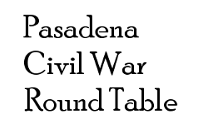Civil War Insights
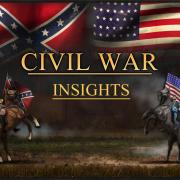
Insights into many different aspects of the Civil War.
This page offers reviews of books on a variety of Civil War topics.
Book review by Austin Krause
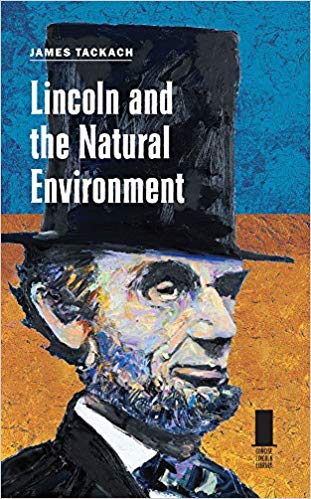 Lincoln and the Natural Environment
Lincoln and the Natural Environment
by: James Tackach
Southern Illinois University Press at Carbondale 2019
Lincoln and the Natural Environment chronicles the origins of United States President Abraham Lincoln’s views on the natural world and analyzes how it influenced his decision making as a young boy, an Illinois representative, and president. James Tackach documents Lincoln’s upbringing in rural Indiana and later as a young man in Illinois and the often extraordinary circumstances his family had to cope with while living on the American frontier. Lincoln’s personal struggles with losing his mother, Nancy, to disease at a young age and witnessing the devastating effects that natural disasters like crop famines had on his family revealed to the him the power of the natural environment. As he entered public life through the Illinois House of Representatives and began the long road to the White House, Lincoln’s views on the environment shifted toward that of an economic perspective.
If the power of the environment could be utilized, Lincoln surmised, then humankind would be able to advance into new stages of evolution. Later, as president, Lincoln came to understand that the natural environment was as delicate as life itself; its vulnerability was revealed to Lincoln as the devastating Civil War raged on and consumed the character of the embattled nation with it. Legislation to protect the environment was passed with Lincoln’s hand and its lasting legacy allowed parks to be created and a segment of American Identity preserved for future generations. Lincoln’s personal relationship with the natural environment is, perhaps, too difficult to assign a simple rating; Lincoln was by no means a “green” leader, even by the contemporary standards of his era. However, as Tackach confirms, the natural environment was a demonstrably critical development with regards to the president’s maturation, general worldview, and public policy decision making; Tackach’s work effectively summarizes this often-overlooked area of President Lincoln’s life as the transformation of the natural environment brought on by his leadership forged a new American character for all to embrace.
Lincoln and the Natural Environment delves into the history of American environmental strategy and its relations with the political economy of the nation. Thomas Jefferson, James Madison, Alexander Hamilton and others are revisited and their often competing values are demonstrated when attempting to deal with habitat destruction and resource loss. Little was offered in terms of a solution, as Hamilton believed resource destruction to be inevitable with economic development and Jefferson expressed strong connections with the planter class and agrarian power. Both had conflicting ideologies with regards to the future of the American landscape. With time, both adapted their perspectives and Jefferson himself ultimately conceded to providing a “grown measure” of urban development and factory growth necessary to sustain farmers in the midst of the booming Industrial Revolution in places like England. Still, few offered any sort of solution to the growing problem of resource loss and devastation facing the young country. It was a problem that, Tackach argues, was swept under the proverbial “rug” by politicians as economic gains swept the nation up in an unprecedented era of boom.
Abraham Lincoln was born in 1809, in the midst of great transformation in American politics and economic progress. Much as with the great American thinkers of old, the views of many Americans were undergoing a rapid evolution as their sights turned to the vast Western frontier that was opening up before their eyes. Without a doubt, young Abraham’s family shared this insight - albeit sparingly, and not remarkably in any sense, as skepticism would keep the head of the Lincoln family, Abraham’s father, Thomas, from the total transformation that instead took so strong a hold of Abraham’s life in later years. Lincoln’s family originated in Kentucky and would soon move to Indiana shortly after Abraham’s birth. He grew up in practical squalor, enduring hardships almost unimaginable by modern standards. Lincoln and the Natural Environment details the young Lincoln’s difficulties with losing his mother and seeing neighbors perish because of natural disasters. Lincoln came to fear the environment as a force of unknowns. He was in awe with its strength and ability to uproot entire communities during poor growing seasons. Simply put, his early experiences with the forces of nature provided to him a tremendous window into a world of opportunity that he would grasp later on.
Lincoln’s life transformed quite fast during the rest of his life in Indiana and the family’s eventual move to Illinois when he was twenty-one years old. As Lincoln aged, his relationship with his father grew thin. His father wanted a successful family, but he saw little future for Lincoln in the intellectual community, which was gripping young Abraham as time went by. Books were stimulating to him and menial work like farming was tedious, unpredictable, and uninteresting. Much to his father’s chagrin, Lincoln moved to the city using money he collected from performing laborious tasks in his twenties and started a newfound life there. While on trips for business or politics to the East Coast, Lincoln travelled by steam engine and rode on big riverboats in vast canals and other new methods of transportation; these trips amazed him, and he began investigating ways of bringing those methods back home with him to Illinois. By the mid-1830’s, Lincoln got involved in the practice of law and sought to become a lawyer, where he felt he could best represent the interests of the rural peoples of the Mississippi River region and the farm belt in general. The practice would help Lincoln develop his ideas of a vastly more efficient political economy that could sustain development the nation - perhaps, even, the world - had not yet seen. Still, Lincoln’s origins as a Kentucky-turned-Indiana farmer influenced his perspectives through to early adulthood. Perhaps to a fault, Lincoln had a fairly narrow worldview in this period. While he embraced new methods of economic development, Lincoln and the Natural Environment provides an instance when Lincoln’s narrow-mindedness was revealed as he attempted to persuade a group of disgruntled Rhode Island Concord farmers to accept the development of the Billerica and Slater dams as a US Representative.
Record numbers of fish were dying out and struggling farmers became enraged as crop yields stagnated and rotations became impossible without the necessary resources. Lincoln failed to understand the anger; after all, the dams helped local grist mills function and provided much-needed goods to needy citizens. After receiving much backlash from such writers as Henry David Thoreau and others who wrote about the dams, he backed off, choosing to revisit the struggles in his own backyard in Illinois and how farmers still felt about similar economic development affecting them. Tackach’s core research about Lincoln’s relationship with the natural environment arises from this time period; the author establishes Lincoln’s foundation with the environment in the middle of the book and from here the reader gains the perspective that the young Illinois representative was about to embark on major transformations of his own.
With a mixed outcome from his first stint as a representative, Lincoln left public office in the early 1840’s and focused on his study of law and the ongoing industrial revolution burgeoning in the nation. To get to this point in his life, Lincoln and the Natural Environment documents Lincoln’s understanding that a revolution in economic development was underway throughout the country, and a force had to help guide it. This evolution, or progression, shaped his viewpoint and put him in line with many Whigs of his day. Lincoln came to support protective tariffs on imported goods to support internal improvements such as railroad building, bridges over rivers, roads to uncharted lands, and funding new inventions like the telegraph and steam engine. Lincoln and the Natural Environment identifies Lincoln’s respect for such luminaries as the “Great Compromiser” Henry Clay for role models. If the power of the environment could be utilized in line with the political models of forward thinkers like Clay, a new era in American ingenuity could be accessed and harnessed. It was a bold step in Lincoln’s life, as this transformation took over his perspectives and utilized his past and present to help shape the world as he interpreted it.
Lincoln’s childhood “fear” of the natural environment developed into a newfound sense of respect as he aged into a respected leader. Harnessing the energy of the environment for the betterment of community meant becoming one with humankind and nature alike. Lincoln, again becoming entertained with the thought of entering public life, produced local results by writing to papers about his proposals. He carried much momentum with his promises to enhance the lives of regular farmers and transform their meager lots into productive futures. With the introduction of tariffs and local measures to procure funding, Tackach argues, Lincoln was able to overcome adversity from the community by providing results to back up his claims.
He built dams, constructed railways to connect isolated townships, and even managed to interconnect the growing Great Lakes economy so local subsistence workers could sample a piece of the economic miracle sweeping the midwest. Lincoln’s popularity soared, and so did his perspectives in production. Unfortunately, and as was the case with the majority of his contemporaries, Lincoln still lacked the perspective necessary to preserve the natural environment and keep it from becoming destroyed as a result of economic advances. Despite admirable attempts to inform and educate by writers such as Thoreau, American political society failed to account for the destruction of the environment brought on by all of this progress. This, too, would come in time; for now, Lincoln’s popularity would carry him into the White House in 1860 and the economic progress from his region would take a backseat to the greatest conflict in American history.
Tackach introduces Lincoln’s political life as one of goals and figuring out measures to obtain those goals. This suited him well as a leader of transformative times. Lincoln knew that to develop a sustainable political economy built on progress and ingenuity, funding was necessary and a reliable base to account for the unpredictability of nature and the environment was critical. Tackach notes that as processes aged, like dams and bridges, funding would be necessary. Of course, this was on the minds of leaders like Lincoln. Because protective tariffs and state bond measures were created under Lincoln’s blessing, for the first time the midwest was able to create a sort of channel for state funds to The state would pay the initial costs and upkeep of the new economic processes, then later reap the benefits of a ten-fold increased import of goods and services. With the creation of reliable flows of income, Lincoln was able to secure a future for his political economy in harnessing the natural environment. Tackach’s work does well to summarize this understanding of Lincoln as a public figure and put his persona into the perspective of the reader in a clear and concise manner.
The American Civil War did much to challenge the identity of the nation in all spheres; notwithstanding differences in industry and resource use, age-old questions looming over institutions like slavery and state sovereignty and contrasts in ideology and sectional politics dominated American political society. The nation quickly devolved into physical strife. The nation’s ability to exist was at stake; its vulnerability was on full display for the entire world to witness. The same could be said for the natural environment in this time. Great armies moved across the landscape, destroying much in their wake and a soaring war economy meant the demand for natural products was greater than ever. Lincoln’s personal eye witnessing of this great struggle and the great loss associated with it revealed to him the fragility of the environment. Short of receiving an epiphany of his own, Lincoln’s views on the environment became far more preservationist in this era and demonstrated a major change from his prior perspectives. Tackach’s Lincoln and the Natural Environment delves into the president’s hands-on legislation which he helped enact - this includes pieces like the Yosemite Valley Grant Act, signed in 1864. This particular piece, one that sets aside land for “public use, resort, and recreation,” inspired future generations of conservationists to take bold steps toward sweeping reform. Lincoln’s administration was the first to authorize bills establishing protected wilderness areas which, notably, paved the way for landmark legislation in the future creating national parks throughout America. Tackach finds the sixteenth president’s primary contribution for conservation as one of legal precedent; President Lincoln introduced the concept of federal regulation and protection for public land use. More notably, the principle of management and the role of federal oversight was created for administering protected lands, granting a strong hand for defending the natural environment and allowing for future administrations to press the advantage for conserving America’s green resources. The transformation of Lincoln’s views of the natural environment was complete with his own maturation and development.
James Tackach’s Lincoln and the Natural Environment is a fresh take on an understudied aspect of Lincoln’s leadership. Tackach does well to contextualize American political society in the era of Lincoln’s upbringing and how it pertained to the natural environment and resource destruction. Of particular interest to readers is Tackach’s inclusion of personal poetry by Lincoln that documents the young man’s perspectives of nature as he traveled the remote interior of the Old Northwest territories. Lincoln’s thoughts on the revolutionary processes he encountered on his journeys are also surveyed and analyzed. Lincoln was an attentive young man who carefully studied his environment and overcame personal struggles to grasp the reigns a new era of progress was affording him. As Tackach’s book also outlines, the environment had a tremendous effect on Abraham’s motivations to become a lawyer and politician; personal sacrifices and tragedy brought out a uniquely sympathetic, prudent and energetic individual ready to forge his own destiny through rural America.
As Lincoln looked to the stream engines, river canals, railroads and other inventions of his day, he surmised that humankind could evolve into a more progressive era of economic development as it utilized these recent advances. All that was needed was unprecedented legislation, opportunity, and boldness, which Lincoln learned to embrace as methods of sustaining this progression. In time, the political society of the country could be transformed for the betterment of all. Abraham Lincoln’s relationship with the natural environment provided the groundwork for a new America - an America where conservation of land, progress through sustainability, the spirit of determination, and evolution of thought would forge a new American character for all to experience.
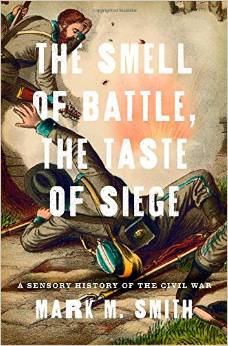 The Smell of Battle, the Taste of Siege: A Sensory History of the Civil War by Mark M. Smith
The Smell of Battle, the Taste of Siege: A Sensory History of the Civil War by Mark M. Smith
"Many Americans experienced their Civil War as a cacophony of exploding shells, the sight of burning buildings, the stench of rotting corpses, the taste of spoiled rations in the armies or mule meat in starving cities under siege, and the touch of unwashed bodies crowded in small spaces. A pioneer in the field of 'sensory history,' Mark Smith re-creates these unpleasant experiences as closely as possible through the medium of the printed word."
–James McPherson, author of Battle Cry of Freedom and winner of the Pulitzer Prize
In The Smell of Battle, the Taste of Siege, historian Mark M. Smith considers how all five senses shaped the experience of the Civil War and thus its memory, exploring its full sensory impact on everyone from the soldiers on the field to the civilians waiting at home.
From the eardrum-shattering barrage of shells announcing the outbreak of war at Fort Sumter; to the stench produced by the corpses lying in the mid-summer sun at Gettysburg; to the siege of Vicksburg, once a center of Southern culinary aesthetics and starved into submission, Smith recreates how the Civil War was felt and lived. Relying on first-hand accounts, Smith focuses on specific senses, one for each event, offering a wholly new perspective.
Often argued to be the first "total war," the Civil War overwhelmed the senses because of its unprecedented nature and scope, rendering sight less reliable and, Smith shows, forcefully engaging the nonvisual senses. Unique, compelling, and fascinating, The Smell of Battle, The Taste of Siege, offers readers a way to experience the Civil War with fresh eyes.
Mark M. Smith is Carolina Distinguished Professor of History at the University of South Carolina and author or editor of a dozen books, includingSensing the Past: Seeing, Hearing, Smelling, Tasting, and Touching in History and How Race Is Made: Slavery, the Senses, and Segregation. Hear Professor Smith speak about the Civil War as an encompassing sensory experience on YouTube.
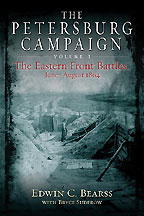

![]() : Thanks for talking with us today, Mr. Bearss. Let me begin by asking you what inspired you to write a book about the Petersburg Campaign?
: Thanks for talking with us today, Mr. Bearss. Let me begin by asking you what inspired you to write a book about the Petersburg Campaign?
ECB: Yes, well we will have to go back a few years to understand the background of how all this came about. The text was written almost 50 years ago in 1958 with the approach of the Civil War Centennial, and I was involved in the preparation for its 50th anniversary. The members of the National Park Service had enjoyed considerable development and expansion during the emergency period of 1933-1942. The emergency conservation program, in which the CCC was acquired, was terminated June 30, 1942 because of the attack on Pearl Harbor. The National Park Service changed drastically with the crisis of World War II. The Park Service had 160 areas under its control, but little attention was given to the park infrastructure. In 1955, the Park Service succeeded in getting the executive department and President Eisenhower interested in Mission 66, a ten-year program to develop the parks, road networks, visitor centers, and trail systems. The Park Service embarked on Mission 66 and a decision was made by the National Park Service and the Civil War Centennial Commission that the Park Service would be treated as a priority in order to preserve the areas established in connection with the Civil War.
![]() : And Petersburg was part of that?
: And Petersburg was part of that?
ECB: Yes. The Petersburg National Battlefield would elevate its standing by adding a visitor center, new interpretive road systems, and historical walkers. To achieve the Park Service goal, I was assumed a position of Research Historian.
![]() : So part of your responsibility was to write about this Campaign?
: So part of your responsibility was to write about this Campaign?
ECB: Not initially. My mission was to provide the Park Service with the necessary information to meet their goals. After working on a number of projects associated with the Park System, especially Civil War, I was given the task of preparing two movement maps and supporting documentation for the major Petersburg operations. I prepared troop movement maps for the Petersburg Campaign, which totaled more than 60 large maps. The maps were finalized and accepted by 1964. The only copies of the troop movement maps are on file at the National Park Service—one set at Petersburg National Park and the other at the National Park Services in Denver, Colorado. To support these troop movement maps I researched and then wrote a number of documented essays. This was the days before easy duplication. One original copy of the essays is on file at the Petersburg National Battlefield Headquarters and five transcripts, which are on very thin tissue paper.
![]() : And these are what editor Bryce Suderow found that inspired him to contact you and discuss publication into book form?
: And these are what editor Bryce Suderow found that inspired him to contact you and discuss publication into book form?
ECB: Yes, he discovered the copies at Petersburg. Bryce is an expert researcher and he thought they were worthy of being published to a larger audience. There was zero funding for reproducing the maps and text and no one until Bryce has thought of reproducing them as a publication until he broached the idea with Ted Savas of Savas Beatie.
![]() : And Bryce, who has helped countless authors with research, helped edit your work for publication . . .
: And Bryce, who has helped countless authors with research, helped edit your work for publication . . .
ECB: Yes, Bryce standardized the notes to meet the publisher’s style requirements, added introductions and conclusions to each essay so they flow together for publication purposes, and George Skoch drafted maps for each of the essays.
![]() : Were any of the battles you write about in Volume 1 “turning points” in the campaign, and if so, why?
: Were any of the battles you write about in Volume 1 “turning points” in the campaign, and if so, why?
ECB: I did not write these essays in separate volumes. How they are being offered is the publisher’s decision, but many are very lengthy, and so two volumes make sense. Now, to your question. The attack on Petersburg on June 9, 1864, which kicks off volume one and was commanded by Maj. Gen. Benjamin Butler, and the assault on Petersburg on June 15 and June 18, were what I consider “turning points” in the campaign.
![]() : And why is that?
: And why is that?
ECB: Because winning those battles was essential. The Union Army missed a great opportunity to capture Petersburg. There would have been no siege of Petersburg if they had won those particular battles. On June 15, the Union army commanded by Maj. Gen. George Meade arrived in Petersburg with members of the First Army Corps, and it is a crucial day in the Petersburg Campaign. It was on that day, I believe, that the losses suffered by the Union make it a darker day for the North than the battle of Pearl Harbor was for America. The casualties exceeded even the casualties at Cold Harbor on June 3. On June 18, many Union army units simply refused to advance. After the failure of the attack on the 18th, there was not another major attack against the Petersburg defenses until July 30th, as a follow-up to the explosion of the mine under part of the Petersburg line held by the Confederates. That, of course, has come to be called the Battle of the Crater. There were many important and bloody operations to follow, of course, but none involved a frontal attack until the battle of Five Forks on April 1, 1865, and the breakthrough that followed during the early morning hours the next day, April 2.
![]() : Why should we remember the Petersburg Campaign?
: Why should we remember the Petersburg Campaign?
ECB: In my opinion, all other battles or sieges in the Civil War pale in comparison to the operations at Petersburg. At Vicksburg in 1863, the armies were eyeball-to-eyeball from May 19 to the Fourth of July. At Port Hudson, the armies were eyeball-to-eyeball from May 21, 1863 until the 9th of July. Other major battles were a day or two long, and that was it. The Petersburg armies were in combat to one degree or another every day, and every day men were killed or wounded, from June 15, 1864 to April 2, 1865. That is more than eight months. That represents by far the longest period during the Civil War in which armies were eyeball-to-eyeball. They built miles and miles of trenches, and while the men manning them shot at one another, other major portions of the armies were maneuvering against rail lines and the important road network feeding Petersburg and Richmond. These maneuvers—which represented Union efforts to turn Lee’s right flank and cut off his lines of supply and communication and his efforts to stop them—resulted in several major battles. The campaign was the precursor to what we would witness in World War I. Comparatively little has been written about the operation of Petersburg.
![]() : Why do you think that is?
: Why do you think that is?
ECB: Rick Summers wrote a masterful book on one of the epics of the siege of Petersburg called Richmond Redeemed. I doubt anyone will ever write such a detailed account of Petersburg again, but Rick’s book only covers the period from September 29 to October 2, 1864. Other books cover the breakthrough at Petersburg, which was from April 1 - April 3, 1865, and there are a few other general histories. None of them go into the level of detail you see with Gettysburg or with Rick’s book, I think, because it is just too vast and too complex, and because many of the records from that period of the war are missing or incomplete.
![]() : Could this campaign have turned out any differently than it did, or do you think once Lee was pinned into the trenches the game was essentially over?
: Could this campaign have turned out any differently than it did, or do you think once Lee was pinned into the trenches the game was essentially over?
ECB: Yes, I think the game was over. Lee’s Army of Northern Virginia and Meade’s Army of Potomac were stalemated in front of Richmond and Petersburg, and it was a presidential election year of course. It is arguable, but I don’t think it would have made much of a difference even if Lincoln had lost the election. The Democratic Convention was convening in Chicago to adopt a peace plan, but even if they had won, the war could not have been successfully terminated until the Democrat—in this case Maj. Gen. George McClellan—took office on March 4, 1865. The Democrats would still have had to work with President Lincoln to win the war before taking office. And by the third month of 1865, no one was going to simply walk away from Petersburg. The war could only end one way. It was important to win the war politically, and Lincoln managed to do that with victories in the Shenandoah Valley under Phil Sheridan and the capture of Atlanta by William T. Sherman. Lee prolonged the war by waging a brilliant defensive effort, but once he was pinned in the trenches he had no hope of coming back.
![]() : How does The Petersburg Campaign differ from other works about these battles?
: How does The Petersburg Campaign differ from other works about these battles?
ECB: Remember, it was written as an internal document and focuses much more on the troop movements and fighting of the various battles. There has been a lot of research since then on Petersburg. It is written based on official records plus regimentals, diaries, etc, that were published before July 1964. There will be a large number of regimental sources. But I think it helps point out the major efforts during the campaign, and perhaps spark additional interest and further avenues of study for others.
![]() : You briefly mentioned General Lee earlier. How would you rate his handling of the campaign?
: You briefly mentioned General Lee earlier. How would you rate his handling of the campaign?
ECB: General Lee fought a masterful defensive operation of what had become essentially a siege. Lee could not continue doing what he had done in 1862 and 1863, which was seizing the initiative and maneuvering to gain an advantage on his opponents. One he was fighting at Petersburg he was essentially locked in place. General Grant’s job was to cut the railroad lines leading south to North Carolina, and southwest out of Richmond and Petersburg to Danville and other points. Every time Grant sent out a force to cut these lines and stretch the Confederates, General Lee engaged it, frustrating Grant in his efforts to cut the cords leading to Richmond and Petersburg, including the very important Southside Railroad. It is not until the operation culminating in the battle of Five Forks on April 1, 1865, that Grant succeeded in cutting that line. Lee’s efforts prolonged the war and this was important because Lincoln was running for reelection. That was the only hope the South had by that time.
![]() : So Lee was successful for many months . . .
: So Lee was successful for many months . . .
ECB: I think it is fair to say that Lee had been generally successful until about the end of March 1865. By that time, Sherman’s army had taken Atlanta, marched to the sea, and was moving north through the Carolinas toward Lee’s position in Virginia. Lee’s situation by that time became all but impossible, and he was finally forced out of Richmond and Petersburg when Sheridan crushed Pickett at Five Forks and Grant ordered an assault the next morning that cracked open the lines.
![]() : Civilians on both sides must have been war weary by that time . . .
: Civilians on both sides must have been war weary by that time . . .
ECB: The public was very war weary, and Lincoln might have lost the election, and that was what the South was hoping for. But as I had stated, Generals Sherman and Sheridan scored victories just weeks before the election, public opinion shifted, and Lincoln won by a landslide. So we will never know what would have happened had he lost. Grant’s operations kept most of General Lee’s army pinned down while other commands won victories in the Shenandoah, Georgia, and in the Carolinas.
![]() : What was your approach to writing The Petersburg Campaign?
: What was your approach to writing The Petersburg Campaign?
ECB: At the time, it was part of my job, but I found it interesting to write documentation for the Park Service managers and interpreters to develop and interpret Petersburg. As I did the troop movement maps, I invariably did a lot of research into the campaign and the commanders involved. I used regimental histories, diaries, journals, and other sources as research, as I mentioned before, including the Official Records.
![]() : What do you hope readers take away from The Petersburg Campaign?
: What do you hope readers take away from The Petersburg Campaign?
ECB: I would like readers to understand that the Park Service is very lucky that Mission 66 was so successful in bringing parks up to standards. A great deal of effort and years of work were spent by Park Service personnel to preserve the areas we’re talking about. There would be few or no visitor centers or interpretive roads without the Park Service.
![]() : Thank you for your time, we appreciate it.
: Thank you for your time, we appreciate it.
ECB: You’re welcome.
To order the Petersburg Campaign use the Pasadena Civil War Round Table coupon code to purchase the book through Savas Beatie and receive an author signed bookplate with your purchase AND free media shipping. Click on the book cover for the respective volumes to order: 
And by entering in the coupon/product code (PCWRT) you will receive an author signed bookplate with your purchase AND free media shipping. *Orders processed through PayPal will receive a refund after the order has been processed (for shipping)
Nick Smith is President of our Civil War Round Table, and also currently Commander of the Rosecrans Camp, Sons of Union Veterans of the Civil War. He has been studying the Civil War since childhood, and has spent the past several years researching Civil War veterans with connections to southern California.
Below you will find Nick’s review of America's Longest Siege: Charleston, Slavery and the Slow March Toward Civil War
America's Longest Siege: Charleston, Slavery and the Slow March Toward Civil War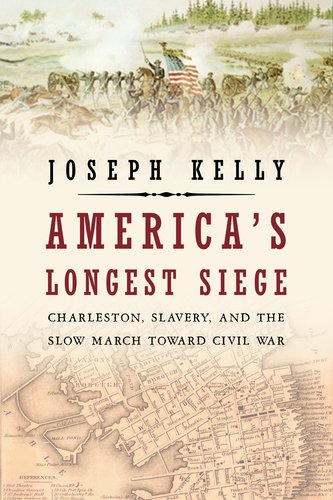
By Joseph Kelly, Overlook Press, a July 2013 release.
This book is an unusual study which presents the unusual premise that the Civil War had causes that can be laid at the feet of a few specific individuals, or at least a small group. This group, representing the rich planters of the Charleston area, changed the overall attitudes of southern society about slavery and squashed dissent at the point in time when serious discussions about the future of slavery were still possible.
Kelly's study suggests that slavery might have died out under its own moral weight if the Charleston planters had not been in such a strong political position. The weakness in this argument is that it ignores the financial momentum which slavery gained in the early 19th century, after the cotton gin and other innovations changed the ways in which slavery was profitable. Much of the financial capital of the south was tied up in slaves or in the infrastructure of slavery, and remarkably few wealthy people will voluntarily impoverish themselves in order to make a social point. In their situation, as Kelly points out, it's easier to change your moral stance, and try to change those of folks around you.
Even with that one small weakness, the book is a fascinating examination of Charleston, and how it could have exercised political and social power far beyond its actual size. More than 50 pages of notes add to the depth of this, and give any serious student a host of options for further reading, but the basic book's 320 pages of text provides quite a bit of both history and historical context. The creation of the "happy slave" myth, along with the "positive good" theory of slavery are put into a context, and we learn why these were created, as well as how.
Other sections vary in depth. The section on Denmark Vesey was fascinating. I had never realized how much his trial had in common with the Salem Witch Trials, until reading Kelly's overview. Also, some other accounts gloss over the size and scope of the panic leading to the trial, which was all about a phantom uprising. The very real uprisings which occurred were somehow never seen as invalidating the "happy slave" concept.
Even the later story of Robert Smalls is put into context, including the later use of his stolen ship in the Union attacks on Charleston later in the war.
Overall, this is a powerful and interesting study of a small part of a nation with cultural leverage. Just as Boston was at the heart of the American Revolution, Charleston spent thirty years or more leading the south toward Civil War.
If you are interested in the long-term causes of the Civil War, this is a book you should read. I would suggest heading to Vroman's or a comparable book store and pre-ordering a copy.
--Nick Smith
